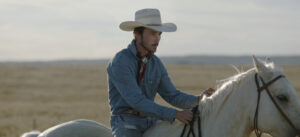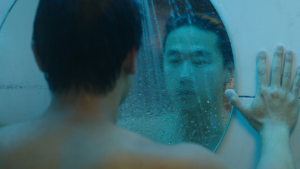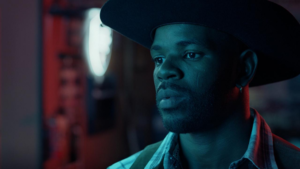Get to Know Your Actors and Their Craft
First and foremost, you as a director must understand the craft of acting if you ever hope to direct others to act in your film. One Way to do this is to get to know actors. Take acting classes, ask other actors about their experiences and get to know them as human beings. “Ask them how they have studied, not because it has to change the way you give direction, [but because] it can be helpful to ask. They usually like to talk about it,” Weston says. “You’d be surprised by how many actors are never asked any questions at all by directors. Actors seem surprised when directors express any interest at all in who they are as an artist or who they are as a person.”
Knowing an actor’s experience also means knowing that their role is never confined to words on a page, so, when possible, they should be involved in decisions being made about their character. This will not only strengthen how you, as a director, present this character on screen, it will also help to maintain a relationship with your actor—especially early in the process. “You can use any excuse to have a conversation with an actor,” Weston says. “Sometimes an actor will feel like they don’t want to have a conversation about the character or the emotional situations for the character. And you can say ‘OK, that’s fine. Let’s talk about your wardrobe. I think you should be in a sharp suit because your character is trying to oppress people.’ It can be an entry into talking about things.”
Getting to know your cast on a personal level is a crucial skill for a director, as the success of an actor’s performance will depend on their ability to bring the character to a deep emotional place of expressing their needs and obstacles, and a personal connection with their directors could help them achieve that. Weston is often asked for examples of common mistakes directors make early in their careers, and removing the personal connection from a relationship is usually the problem.
One particular example of disconnect between a director and actor involved a director sending a list of ten or twelve films to an actor, instructing her to watch them all in preparation to work with him. “That is not helpful,” says Weston. “You should tell them why you think a movie is important, but tell them face to face. Say ‘I want you to watch Dog Day Afternoon because a lot of it was improvised and I would like us to use some improv,’ or ‘I want you to watch some Cary Grant movies because I want to use that kind of pacing. But saying you want to imitate the success of a recent movie is a lot of pressure.” She also adds that no direction with actors should ever happen over the phone or email; these conversations need to happen face to face. Ultimately, understanding actors comes down to one key piece of advice: “Listen more than you talk. And practice listening,” she advises.
Practice is the only way to gain experience, and experience is necessary in the complicated and difficult field of directing. “Do not have your first directing experience be on a set where someone has put up a million dollars. Don’t do it,” she says. Practice is essential, and it’s not a burden on others; in fact, it’s useful to anyone interested in honing their craft. “Practicing with people who are not going to be in your movie is fantastically useful. You don’t have to worry about making a mistake. You don’t have to worry about saying something and losing their trust and the whole project going up in flames because you’ve lost their trust,” she says. “If you make it clear that it is all just people helping each other and practicing connection, that is practice for everybody,” Weston explains.
Begin Investing in Your Actors During Casting
Although connections need to be made face to face in order to feel the full value of a new working relationship, Weston is aware that our world has dramatically changed in recent years and face to face interactions may not always be possible or safe in the early stages of a project. As many auditions continue to take place over Zoom, Weston has some practical advice: “To make up for the formality of zoom, insist on informality in the interaction,” she says. “You should say from the onset, ‘This is not a rehearsal. This is not a casting session. This is not an audition.’ It’s really helpful to say that at the beginning to give them permission to fail.” Instead of making a meeting a traditional casting session, it’s better to make early meetings with actors about connection. “If we learn something about the character together, that will be a plus.”
There is an upside of having early casting meetings online: it allows you to gain more practice in running casting sessions, which is particularly valuable for directors who are early in their careers. “You have a perfect excuse because Zoom is still new and you can say you feel comfortable with a casting session in person, but you would really like to practice, so will they help you? Get people that are nice, loving people who will give you good, constructive feedback on whatever happens in the casting session,” she suggests.
Again, much of the casting process comes down to listening. “Part of this suggestion for running auditions is to let them come in and do it their way, the way they have in mind, their idea. It’s important to see that they have ideas, and then you can suggest a different objective.” The relationship between directors and actors will be a collaborative one from start to finish, so including them in the construction of the character early on will set a good foundation for both of you moving forward. “Actors love to feel that they have shown everything they have to give, and if they don’t get the job, they do not feel so bad and walk out and wonder what they did wrong.”
Once you’re in the process of the audition, Weston recommends practicing “As ifs,” with actors, meaning they should be given space to change the lines they read based on their relationship to each other. “Have them do the scene as if they’re business partners when the scene is, in fact, between a married couple,” she explains. “You want to be able to see if they can do that in the audition so that you are not faced with that when you get to the set.” In fact, all of this work and communication takes place before an actor has even been cast in the role.

Allow Plenty of Time for Rehearsals
Once your actors have been cast in their respective roles, rehearsals need to be scheduled and taken seriously. When teaching in her workshops, Weston is often about connecting with actors if you’re meeting them on the first day or a shoot, or how to manage the directing process with little to no rehearsal time. She has a simple response: “Don’t let this happen.”
Rehearsals are a critical time to continue building the connections you started in the casting process. At the start of the rehearsal period, it’s advisable to meet with each principal actor one-on-one and ask them some fundamental questions about the role: why did they take the job? How do they feel connected to the script or the character? What do they think the story is about? While asking these questions, don’t forget to open up about these things yourself; it’s important to tell them why you feel a connection to it and why you want to direct. “You will save time if the project is based on connection, so this is a really important thing to do,” says Weston.
Since filming involves multiple takes and a story that will continue to evolve through post-production, the focus of rehearsal should not be to repeat an exact performance. “You can make choices and commit to those choices over and over, and objectives and blocking can be repeated,” Weston explains, “but the purpose of rehearsal is not to get the performance right, it is to warm up.” With that in mind, leaving space for improvisation in rehearsals is also important, since you will want to avoid the “analysis paralysis” that comes from too much discussion or the repeating of lines to the point that actors fall into reading rather than rehearsing. Ultimately, you will need to ground your work in directing the scene rather than the performances themselves, always considering the emotional events of the scene and how they express to the audience what the scene is about.
“Know that it’s a craft. It’s going to take awhile to learn how to do it,” Weston says, but adds, “Don’t look down on the things that you’re good at.” Your skills outside of directing can come in handy with rehearsals as well; for example, Weston’s previous experience as a waitress helped her to be a better actor early in her career because she learned how to listen and be in service to those around her – a skill that has come in handy in many rehearsals.
Establish a Privacy Agreement
Weston emphasizes that when establishing early relationships with your actors, it is vital to make a privacy agreement with each of them. A lot of stress, disagreements and challenges will inevitably arise during the making of a film, so a mutual commitment must be made to discussing those challenges in a safe environment behind closed doors.
“Honesty is so counterintuitive in daily life,” she says. “People ask how you are and what do you do? You say ‘I’m fine.’ Day after day of this makes honesty counterintuitive. You have permission in the creative world and in the imagined world to go beyond that and to create a purity of expression.”
Weston advises directors to be as up front as possible and let actors know, “You can say anything you want to me. You can be mad at me, you can complain about any member of the team, as long as you do it privately to me alone. In return, I will listen to anything you have to say, even if it seems unfair… and I will fix it if I can.” According to Weston, the key to this conversation is adding, “As long as nobody else can hear. We have to make sure there’s no criticism or yelling in front of anybody.”
Due to the intimate and emotional nature of the work, actors will have a relationship to one another different from any other relationships among the crew, and it will be important to be mindful of how they treat one another on set. “It’s very unprofessional for an actor to criticize another actor’s performance. You want to make sure it doesn’t happen in front of other people,” Weston warns, and it will be your job as the director to avoid such situations.
In extreme cases, pent up frustrations can lead to an argument or a meltdown on set, which is going to be disastrous for the project. “If you’re worried that it could happen, that’s going to shut you down. Handle that ahead of time, don’t wait for something bad to happen. Does it sound scary to do that? Practice! Don’t wait until someone else’s two million dollars is riding on it and you’re scared to death you will let people down. Practice telling people they can be honest with you, and practice being honest with them. Honesty is so important.”
Adjust Your Process for Non-Actors and Children
When working with non-actors, many of the same principles of listening and establishing trust still apply. However, you need to be conscious of the fact that non-actors may not have the tools to handle backstories or simple directions on performance. “It’s very helpful with non-actors to get them centered in the idea that they are responding to another actor rather than generating a performance. As soon as they get the idea in their heads that they are generating a performance, they are no longer non-actors, they are now poorly trained actors,” Weston explains.
The entire point of casting a non-actor would be their own personal connection to the scene and story. ”If you want to cast non-actors, you will want to cast non-actors that are perfect for the role and don’t have to do any acting,” says Weston. She describes a story about the film Sling Blade, in which director Billy Bob Thornton cast a janitor to play a janitor in the film and suggested he pick a fight with another character. The man pushed back, insisting that he, as a real employee at a hospital, would never treat a patient that way. “Use their strengths rather than turn them into something they are not,” Weston says.
With non-actors, it’s best to keep them in a comfortable role and again, establish a trusting relationship. “Even for professional actors, sets are intimidating. For non-actors, can you imagine how intimidating that is?” says Weston. Additionally, it’s best to avoid over-complicating the role. “Sometimes people say they want to be in a movie but they don’t know what’s involved. It’s better for non-actors to be in smaller roles without too many lines.”
When casting non-actors, you have to find people who will be naturally curious with a strong sense of imagination, and this is particularly true when working with children. Weston also warns that working with children will vary a little depending on their age. Children over eight years of age will be able to understand directions in a more concrete way, whereas younger children have more of a need to be protected.
“Use your imagination and lead them,” suggests Weston. “Tell them, ‘We’re in a forest, is there a rock over there? What should we do?’ You have to be careful where you lead them because they’re so very impressionable.” Because of that vulnerability, Weston cautions against bringing up hypothetical situations in order to get them into character. “Never bring up the topic of sick mothers with children under eight years old,” she says. “Just say, ‘can you be sad if I ask you to?’” With young children, it’s also helpful to give them something physical to do in a scene and, similar to working with non-actors, take away as much dialogue as you can.
Weston also shares a story about the film Rabbit Proof Fence, which had three children, ages nine, seven and five, as main characters, none of whom had ever acted before. They spent six weeks in a bootcamp of sorts with a trained actress learning safe methods to access the emotion required for the roles and to get used to the lights and cameras.
With children and adults alike, the balance of communicating with them and letting go enough to trust their performance is a skill that all directors need to learn. “It’s not all up to you to get their performance,” says Weston. Sometimes, it is getting out of their way, and sometimes, it’s pushing and saying ‘I know you can do more, I know you can dig deeper.’ Tell them they can take risks, even if you think they’re going over the top.” And remember: when you’re asking for more from your actors, you need to be sure that you, as the director, are equally willing to do the work. “The best way to direct them is to remember what the scene is about, the emotional event. You have to be able to back it up with your knowledge of life and your artistic intention.”



